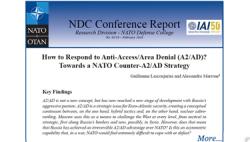How to Respond to Anti-Access/Area Denial (A2/AD)? Towards a NATO Counter-A2/AD Strategy

Anti-access/area denial (A2/AD) has been high on the US agenda in recent years, but today such a threat is also facing Europe. NATO should therefore think about A2/AD as an additional challenge to the Alliance’s security. As Russia develops options allowing it to interdict access to nearby seas and skies in wartime, an “Arch of Steel” is descending across the continent, from the Arctic through the Baltic to the Black Sea. The illegal annexation of Crimea, and the increasing number of troops and advanced weapons in the port city of Kaliningrad, could prevent NATO’s freedom of movement in these regions. The narrow corridor connecting Poland with Lithuania — the “Suwalki Gap” — is the only land link between “mainland” NATO members and the Baltic States. It could, potentially, be cut off, thus challenging the Alliance’s ability to reinforce these countries other than by air or sea. Moreover, Russia is also positioning A2/AD capabilities in Syria.
A thorough understanding of A2/AD requires far more than a focus on the obvious military aspects and capabilities, which are actually only the tip of the iceberg. Of course, a look at weaponry and systems that would be used in denying access is critical. Equally important, though, is a comprehensive analysis of NATO member states’ capabilities to maintain a strategic and technological edge, so as to guarantee this access, whenever and wherever it might be needed. But even more than this, a multifaceted approach is mandatory: A2/AD can be seen as a policy challenge that requires NATO to fully understand what is at stake and how it can properly respond, while taking into account the risk of escalation.
This report presents the results of a one-day workshop in Rome in January 2016, held in cooperation with Istituto Affari Internazionali (IAI), and addresses the possible elaboration of a “NATO Counter-A2/AD Strategy”. It not only summarizes the discussions which took place during the meeting, but gathers the main findings and recommendations for NATO stakeholders to consider on their road to the Warsaw Summit.
Rapporto del seminario organizzato a Roma il 20 gennaio 2016 da Nato Defence College (NDC) e Istituto Affari Internazionali (IAI).
-
Dati bibliografici
Rome, NATO Defense College, February 2016, 12 p. (NDC Conference Reports ; 01/16)
Key Findings
Introduction
A2/AD: Continuity or Innovation?
Russia, its Strategy, Military Modernization and A2/AD Capabilities
A2/AD: An Operational Perspective
NATO’s Way Forward: Policy and Capability
Conclusion
Tema
Tag
Contenuti collegati
-
Evento10/02/2016
How to respond to Anti-Access/Area Denial (A2/AD)? Towards a NATO counter A2/AD strategy
leggi tutto -
Ricerca21/01/2014
Partnership con il NATO Defense College
leggi tutto



